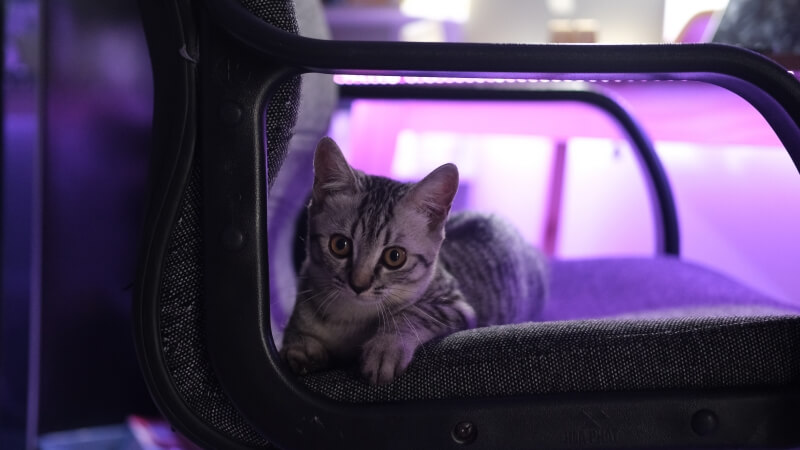
How To Craft A Cozy Cat Vest From Fabric Strips
Have you ever seen your feline friend lounging around and thought, “What could possibly make this picture more adorable?” The answer is simple: a cat

Traveling with a cat in a car might seem a bit unusual at first. The combination of felines and vehicle journeys doesn’t typically come to mind as a harmonious duo. And indeed, many would concur with this sentiment.
However, embarking on a road trip with your feline companion can be an unexpectedly delightful experience. Not only can your cat start to find joy in these adventures, but you also benefit from not needing to arrange for a pet sitter while you’re away.
Sure, it requires some planning and training, but don’t worry, we have all the essential guidance you need for car travel with your cat. From cross-country treks to brief jaunts, continue reading for 13 indispensable tips for a successful cat road trip!
Embarking on a long-distance journey with your cat in the car involves more than just packing your bags and setting off. It’s important to strategize and ensure that both you and your feline friend are ready for the journey ahead.
If your cat is already training a harness and leash, that’s a great start. However, there are additional preparations you’ll need to consider to ensure a smooth and comfortable trip for both of you.
It is crucial for your cat to always be in a carrier during car travel. Regardless of your cat’s behavior, a carrier is the safest option for transportation.
Unexpected situations like sudden braking, a potential car accident, or something frightening your cat can occur at any time. A carrier ensures the safety of your cat, yourself, and other drivers.
Our top recommendation is the mobile pet bed. This innovative product serves as both a cat bed and a carrier, providing your cat with the comfort of their own bed while traveling. This is especially beneficial for cats that find travel stressful. It features a mesh-dome top for your cat to observe their surroundings comfortably.
The most impressive aspect is its proven safety in crash tests. It can be securely fastened with a seatbelt and is designed to withstand car accidents, offering peace of mind during your journey.
For cats not used to car rides, gradual introduction is key. Place them in the carrier you plan to use for your trip, and take a short drive around the neighborhood. Gradually increase the distance with each trip, ensuring their first long journey isn’t a sudden cross-country adventure.
*Carrier Tip: To familiarize your cat with the carrier, keep it accessible in your home. Consider feeding them inside it, so they start associating it with positive experiences. The goal is for your cat to see the carrier as a secure and comfortable space, not just a travel accessory.
While it’s unlikely you’ll lose your cat during your travels, being prepared for every scenario is wise. Ensure your cat’s ID tags have current information before embarking on your trip.
Additionally, if your cat isn’t already microchipped, you might want to consider this extra precaution. A microchip can be a vital tool in reuniting you with your cat should they wander off unexpectedly.
Traveling with a cat means you can’t just spontaneously choose any hotel like you might when traveling alone. Locating cat-friendly lodging requires more effort. It’s best to make reservations in advance to ensure you have a suitable place to stay.
Always verify that your chosen accommodations explicitly welcome cats. The term “pet-friendly” doesn’t necessarily mean cats are included, as many places cater primarily to dogs.
When booking, directly inquire about their policy on cats. Also, ask about any additional fees for bringing your cat. It’s important to avoid unexpected charges at check-out.
For short road trips, a litter box in the car might not be necessary. However, on longer journeys, you need a strategy for your cat’s bathroom breaks. There are several approaches to manage this while traveling with a cat by car.
Consider these options for a travel litter box:
It’s essential to have a plan but also to recognize that your cat might not adhere to it. For instance, some cats may refuse to use the litter box in the car and wait until reaching the destination.
The best approach is to be prepared with multiple options. Have a litter box ready for pit stops and line the carrier with pee pads as a backup. Cats’ bathroom behaviors on road trips can be unpredictable, so offer them choices until you understand their preferences.
Traveling with cats often means packing more for them than for yourself. Cats require quite a few items, ranging from the basic necessities like food, water, and a litter box, to the less obvious items such as a dustpan and broom, trash bags, and a can opener.
Creating a detailed list is the best way to ensure you don’t forget anything important. Remember to include all the essentials and consider items that could make the journey more comfortable and less stressful for your cat.
It’s advisable to pack extra supplies like food and litter. It’s better to be over-prepared than to find yourself short of something essential during your trip.
All the preparations are complete, and you and your cat are ready to set off on your journey. To ensure a smoother road trip, there are several steps to follow before hitting the road:
To reduce the risk of your cat feeling sick or nauseous during the drive, avoid feeding them several hours before departure. They’ll be fine waiting to eat until you arrive at your destination later in the day.
Like humans, some cats experience motion sickness. If this is the case, consult your veterinarian for appropriate medication or advice on over-the-counter options.
Similarly, if your cat is prone to stress during car rides, there are various prescription and non-prescription sedatives and calming agents that might help. Remember, always consult your veterinarian before administering any medication.
Ideally, your cat will sleep through most of the trip, which can minimize stress and the need for bathroom breaks or feeding. If your cat is used to car rides, they might manage several hours without issues.
For first-time travelers, playing and exercising before the journey can help tire them out, increasing the likelihood of them resting calmly during the trip.
While you can’t explain the benefits of using the litter box before the trip to your cat, you can encourage them. Placing them in the litter box before leaving might prompt them to go.
Now that you’re all set with preparations and training, it’s time to begin your journey. Even on the road, there are important considerations to ensure a smooth trip with your cat.
While most of your luggage can be stored in the trunk or back of your car, it’s crucial to have a bag with your cat’s necessities easily accessible. Items like water, treats, medication, pee pads, and anything else you might need quickly should be kept close at hand.
For shorter trips, your cat might not need a break, but on longer drives, plan to stop every few hours. These breaks provide your cat with a chance to drink water and use the bathroom.
If your cat is trained to use a harness, take this opportunity for a brief walk and some leg stretching. If not, allow them some time to roam inside the car before continuing your journey.
It’s critical to never leave your cat alone in a car, particularly in extreme weather conditions. But what if you’re traveling alone and need a restroom break?
One solution is to have a spare set of car keys so you can keep the car running with the air conditioning or heater on, and the doors locked while you quickly use the restroom.
If a second set of keys isn’t an option, pre-cool or pre-heat the car before your stop. When you park for your break, leave your cat in the car and return as swiftly as possible to avoid leaving them in extreme temperatures without climate control.
Here’s a video guide you can follow to plan your trip with your cat if you don’t want to read the text!
Traveling with a cat in a car can be a rewarding experience for both you and your feline friend, with proper preparation and consideration for their needs.
This comprehensive guide has provided you with all the essential tips and steps to ensure a safe, comfortable, and enjoyable journey for both you and your cat.
From selecting the right carrier to making regular pit stops, each aspect plays a crucial role in making your road trip a success.
Remember, the key to a smooth trip lies in thorough preparation, understanding your cat’s behavior, and being adaptable to their needs.
Whether it’s a short drive or a cross-country adventure, these guidelines will help you navigate the challenges and joys of traveling with your furry companion. Enjoy the journey and the unique bond it creates with your cat, exploring new places together.
FAQ: How do I keep my cat entertained during long car rides?
A: To keep your cat entertained, bring along their favorite toys or introduce new ones specifically for the journey. Also, playing calming music or cat-specific audio can help keep them relaxed and engaged.
FAQ: What should I do if my cat refuses to enter the carrier?
A: If your cat is reluctant to enter the carrier, try using treats or catnip to encourage them. Gradually acclimating them to the carrier at home, by allowing them to explore it at their own pace, can also help.
FAQ: Can I feed my cat during a road trip?
A: Yes, you can feed your cat during longer road trips. It’s best to offer small, light meals to avoid upset stomachs. Also, keep a consistent feeding schedule similar to their routine at home.
FAQ: How do I handle a cat that meows constantly in the car?
A: Continuous meowing might be a sign of stress or discomfort. Try to calm your cat with soothing words or gentle petting. Ensure the carrier is comfortable and familiar, and consider using a pheromone spray for relaxation.
FAQ: Is it safe to open windows while my cat is in the car?
A: It’s generally not safe to open windows fully while your cat is in the car, as they might try to escape or get injured. However, you can crack the windows slightly to ensure proper ventilation, especially if the cat is secured in a carrier.


Have you ever seen your feline friend lounging around and thought, “What could possibly make this picture more adorable?” The answer is simple: a cat

The moment you consider a dog hunting vest for your adventurous companion, you’re stepping into a world where safety meets functionality. This vest is not

The concept of a dog cooling vest is a game-changer for pet owners looking to enhance their dog’s comfort during those relentless summer days. Imagine

When you first consider crafting a tactical dog vest, it’s not just about embarking on a fun DIY project; it’s about ensuring your furry companion’s

Have you ever seen your feline friend lounging around and thought, “What could possibly make this picture more adorable?” The answer is simple: a cat

The moment you consider a dog hunting vest for your adventurous companion, you’re stepping into a world where safety meets functionality. This vest is not

The concept of a dog cooling vest is a game-changer for pet owners looking to enhance their dog’s comfort during those relentless summer days. Imagine

When you first consider crafting a tactical dog vest, it’s not just about embarking on a fun DIY project; it’s about ensuring your furry companion’s
Secure and Empower, Walk Responsibly
Copyright © 2025pettacticalharness. All Rights Reserved.